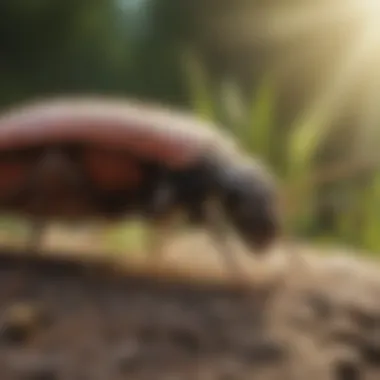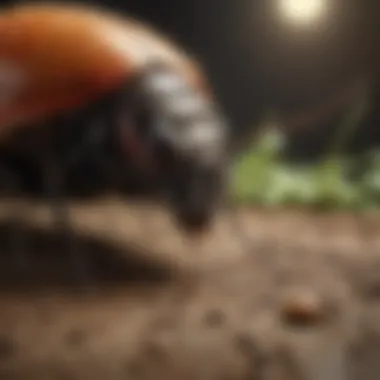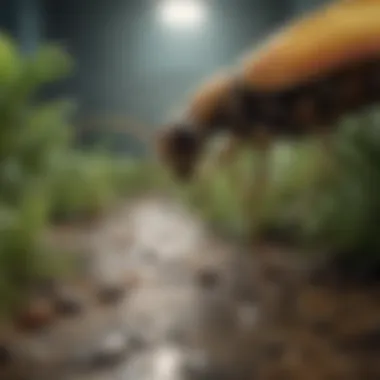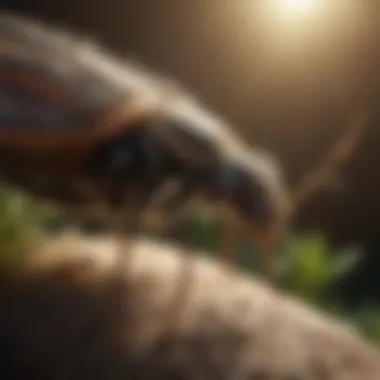Unveiling the Significance of Insect Growth Regulators in Targeted Pest Control Strategies


Preventive Pest Control Strategies
Pest control is a crucial aspect of maintaining a clean and healthy home environment. One of the primary steps in effective pest control is implementing preventive strategies to avoid infestations. Here, we will delve into various preventive pest control measures that homeowners can take to proactively protect their homes from pests.
House Exterior Protection
Protecting the exterior of your house is essential in keeping pests at bay. One method is to seal cracks and crevices around doors, windows, and foundations to prevent pests from entering. Clearing debris such as leaves, branches, and clutter from around the house can eliminate hiding spots for pests. Additionally, using weather-stripping and proper screening on windows and doors can help in preventing pests from finding their way indoors.
Yard Maintenance
Maintaining a well-kept yard is vital for pest control. Regular yard care routines like mowing the lawn, trimming shrubs, and removing standing water can reduce breeding grounds for pests. Employing pest-resistant plants and implementing proper drainage systems can further aid in keeping the yard pest-free.
Indoor Cleanliness
Indoor cleanliness is key to preventing pest infestations. Expert cleaning tips include frequent vacuuming, clearing clutter, and proper food storage to eliminate food sources for pests. Maintaining a pest-resistant indoor environment involves sealing cracks and crevices, fixing leaks, and practicing good sanitation habits.
Garbage Disposal
Proper garbage disposal is essential in deterring pests from your home. Using sealed trash bins, disposing of garbage regularly, and keeping outdoor bins away from the house can prevent attracting pests. It is crucial to follow efficient waste disposal methods to avoid pest infestations.
Other Pest Prevention Strategies
Apart from the mentioned strategies, there are various innovative ways to safeguard your home against pests. Implementing natural pest deterrents like planting mint or lavender, installing ultrasonic pest repellers, and using diatomaceous earth can aid in pest prevention.
Introduction
In the realm of pest control, the utilization of Insect Growth Regulators (IGRs) holds a pivotal role. These compounds offer a nuanced and targeted approach, specifically designed to disrupt the growth and development processes of pests. Amidst the plethora of pest management strategies, the incorporation of IGRs stands out as a method that focuses on precision and effectiveness. By delving into the intricate mechanisms of IGRs, we can uncover valuable insights into their efficacy within integrated pest management programs.


Defining IGRs
Chemical Composition
IGRs boast a distinct chemical composition that sets them apart in the realm of pest control. This composition plays a crucial role in their ability to target pests effectively. The key characteristic lies in their ability to mimic the hormonal system of insects, leading to disruptive effects on growth and development. The unique feature of this composition is its selective nature, which enables them to target pests while posing minimal risk to non-target organisms. This selective action makes IGRs a favorable choice for environmentally conscious pest control strategies.
Mode of Action
The mode of action of IGRs further contributes to their significance in pest control. By disrupting key processes such as molting and metamorphosis, IGRs impede the growth and maturation of pests, ultimately reducing their population. The distinctive feature of this mode of action is its specificity towards insects, ensuring minimal impact on other organisms. This targeted approach enhances the efficacy of IGRs in pest control, making them a preferred choice for integrated pest management programs.
Importance in Pest Control
Targeted Approach
An essential aspect of IGRs is their targeted approach towards pest control. Unlike broad-spectrum insecticides, IGRs specifically interfere with the growth and development of insects, leaving beneficial organisms unharmed. This precision targeting is a valuable benefit, as it reduces the collateral damage often associated with traditional pest control methods.
Environmental Impact
The environmental impact of using IGRs in pest control is a significant consideration. Their selective nature and targeted approach result in minimal disruption to the ecosystem. By minimizing harm to non-target organisms and reducing the overall chemical load in the environment, IGRs offer a more sustainable solution to pest management. This environmental consciousness makes IGRs a preferred choice for those seeking effective yet eco-friendly pest control options.
Mechanisms of Action
In this segment, we delve into the intricate mechanisms of action of insect growth regulators (IGRs) in pest control. Understanding the mechanisms underlying IGRs is crucial as it forms the foundation for their efficacy in managing pest populations. By elucidating how IGRs target specific processes in insect growth and development, we can comprehend the precise way in which these regulators disrupt the life cycles of pests, leading to effective pest control strategies. The detailed exploration of IGRs' mechanisms of action sheds light on their pivotal role in integrated pest management programs.
Disruption of Growth
As we investigate the disruption of growth caused by IGRs, we focus on two key aspects: effects on molting and inhibition of metamorphosis. These effects play a paramount role in impeding the normal growth and development of insects, thereby curbing the proliferation of pest populations.
Effects on Molting


When discussing the effects of IGRs on molting, we highlight how these regulators impact the molting process in insects. By interfering with molting, IGRs disrupt the shedding of exoskeletons, hindering the insect's growth and ultimately leading to mortality. This unique feature of IGRs in targeting molting is advantageous as it provides a specific and focused approach to pest control, minimizing harm to non-target organisms in the environment.
Inhibition of Metamorphosis
Inhibition of metamorphosis is another critical aspect of IGRs' disruption of growth. By blocking the transformation of insects from immature to adult stages, IGRs prevent the reproduction and maturation of pests, significantly reducing their population growth. The distinctive characteristic of inhibiting metamorphosis with IGRs offers a precise and effective method for pest control, ensuring that pests do not reach reproductive stages and reproduce, thus mitigating infestation risks.
Regulation of Reproduction
In examining the regulation of reproduction by IGRs, we consider two significant factors: impact on fertility and interference with egg development. These aspects highlight how IGRs affect the reproductive capabilities of insects, leading to a decline in pest populations.
Impact on Fertility
The impact of IGRs on fertility is key to disrupting the reproductive cycle of insects. By rendering pests infertile, these regulators impede the ability of insects to reproduce, consequently curbing population growth. The notable feature of IGRs in influencing fertility offers a targeted and sustainable approach to pest management, reducing reliance on traditional insecticides and minimizing environmental impacts.
Interference with Egg Development
Interference with egg development through IGRs further solidifies their role in regulating reproduction among pests. By impeding the development of viable eggs, IGRs prevent the proliferation of pest populations at their source, effectively controlling infestation levels. The unique feature of interfering with egg development using IGRs presents a strategic and environmentally friendly option for pest control, ensuring long-term efficacy and sustainable pest management practices.
Application in Integrated Pest Management
In the realm of pest control strategies, the application of Insect Growth Regulators (IGRs) holds a paramount position. Integrated Pest Management (IPM), a holistic approach that incorporates various control methods, benefits significantly from the usage of IGRs. By integrating IGRs into IPM programs, pest control efforts become more targeted and effective. One of the key advantages of using IGRs in IPM is their ability to disrupt the growth and development of pests in a specific manner, unlike broad-spectrum insecticides. This targeted approach minimizes the impact on non-target organisms and the environment, making it a sustainable choice for pest management. The incorporation of IGRs in IPM also enhances the overall efficacy of pest control programs by offering long-term solutions that address the root causes of pest infestations.
Synergistic Approaches
Combination with Biological Controls
When exploring synergistic approaches in pest management, the combination of IGRs with biological controls emerges as a promising strategy. Integrating IGRs with biological control agents such as natural predators or parasites enhances the overall effectiveness of pest control programs. This combination leverages the strengths of both methods, where IGRs target specific pests at their vulnerable growth stages, while biological controls act as natural regulators of pest populations. The key characteristic of combining IGRs with biological controls lies in its ability to provide a comprehensive solution to pest infestations without relying solely on traditional chemical treatments. This approach not only reduces the reliance on synthetic pesticides but also contributes to a more sustainable and environmentally friendly pest management system. However, one must consider the potential limitations of this approach, such as the need for continuous monitoring of the pest populations and understanding the compatibility between IGRs and biological control agents.


Enhancement of Chemical Treatments
In the realm of pest management, enhancing chemical treatments with IGRs plays a crucial role in improving the efficiency of control methods. The key characteristic of integrating IGRs to enhance chemical treatments lies in their ability to provide a dual-action approach to pest control. IGRs, with their growth-regulating properties, complement the knockdown effects of traditional insecticides, resulting in a more comprehensive eradication of pest populations. This synergistic combination not only increases the overall efficacy of chemical treatments but also reduces the likelihood of resistance development in pest populations. However, it is essential to note that while the enhancement of chemical treatments with IGRs offers numerous benefits in terms of pest control, careful consideration must be given to potential drawbacks such as the development of resistance to IGRs among pest species and the impact on non-target organisms.
Resistance Management
Delaying Resistance Development
Mitigating resistance development in pests is a critical aspect of effective pest management strategies. By incorporating IGRs into pest control programs, resistance development can be delayed significantly. The key characteristic of IGRs in delaying resistance lies in their targeted mode of action, which disrupts specific physiological processes in pests, making it challenging for them to develop resistance rapidly. This delayed resistance development ensures that IGRs remain effective over extended periods, providing sustainable solutions for pest control. However, it is crucial to rotate IGRs with other control methods periodically to further delay resistance and maintain the long-term efficacy of pest management programs.
Reducing Reliance on Traditional Insecticides
Reducing reliance on traditional insecticides is a key objective in modern pest management approaches, and IGRs play a central role in achieving this goal. The key characteristic of IGRs in reducing reliance on traditional insecticides is their unique mode of action, which targets specific biological processes in pests without harming beneficial organisms. By incorporating IGRs into pest control programs, the dependency on broad-spectrum insecticides decreases, minimizing the environmental impact and promoting sustainable pest management practices. However, while the reduction in reliance on traditional insecticides offers numerous benefits, including decreased chemical residues in the environment and reduced harm to non-target species, it is essential to continually assess and adapt pest control strategies to prevent the development of resistance to IGRs among pest populations.
Future Perspectives
In the realm of pest control, anticipating future perspectives is essential for staying ahead of evolving challenges. Looking forward, advancements in formulations promise revolutionary changes in combatting pests effectively. These innovations not only enhance the potency of treatments but also align with the pressing need for sustainable pest management strategies. By leveraging cutting-edge technologies, the efficacy and precision of pest control methods can be significantly boosted. Embracing these developments ensures a proactive approach to pest management and underscores the importance of continual adaptation in the face of emerging pest threats.
Advancements in Formulations
Nanoencapsulation Technology
Nanoencapsulation technology represents a paradigm shift in pesticide delivery mechanisms. Encapsulating active ingredients at the nanoscale offers numerous advantages, such as improved stability, controlled release, and enhanced bioavailability. The small size of nanoparticles allows for targeted delivery of insect growth regulators (IGRs), ensuring maximum impact on pest populations while minimizing off-target effects. This innovation revolutionizes the efficacy of IGRs, making them a formidable choice for holistic pest control solutions. Despite its promise, nanoencapsulation technology also presents challenges related to regulatory approval and potential environmental impacts, demanding a careful balance between innovation and risk management.
Enhanced Persistence
Enhanced persistence, a key feature of modern IGR formulations, prolongs the residual activity of these compounds. By increasing the longevity of IGR effects, enhanced persistence ensures sustained control over pest populations, reducing the need for frequent reapplications. This characteristic significantly improves the cost-effectiveness and efficiency of pest management programs, aligning with the growing demand for long-lasting solutions. However, the extended persistence of IGRs also raises concerns regarding the potential buildup of residues in the environment and the development of resistance in target pests. Balancing the benefits of enhanced persistence with responsible use is crucial to maximizing the effectiveness of IGRs in pest control.
Expansion to New Pest Species
Expanding the target spectrum of IGRs broadens the scope of pest control applications, offering comprehensive solutions against a wider range of pest species. By addressing specific characteristics of new pest populations, IGRs can adapt their mode of action to suit varied infestation scenarios. This versatility enhances the versatility of IGR-based treatments, making them a versatile choice for integrated pest management practices. However, diversifying the target spectrum of IGRs also necessitates thorough research into their efficacy on different pests and the potential ecological impacts of expanding their use. Mitigating these challenges while harnessing the benefits of broadening target spectrum represents a pivotal step towards optimizing pest control strategies.
Adapting to Emerging Pest Challenges
As pest populations evolve and adapt to conventional control measures, IGRs play a critical role in addressing emerging pest challenges. By modulating their formulations and application techniques, IGRs can effectively counteract resistance mechanisms developed by pests. This adaptability enables IGRs to remain a potent weapon against changing pest threats, safeguarding agricultural productivity and environmental sustainability. However, adapting to emerging pest challenges requires ongoing research and innovation to stay ahead of evolving pest populations. Balancing the dynamic nature of pest control with sustainable practices is fundamental to the continued efficacy of IGRs in mitigating emerging pest challenges.



